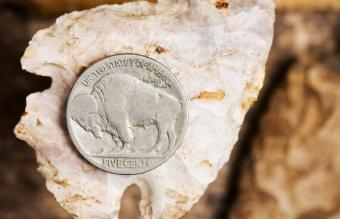
Buffalo nickel values are closely related to the fascinating history of this coin. Plagued with minting problems and excessive wear points, this nickel was only produced for a 25-year period. During this time, which began in 1913, over 1.2 billion buffalo nickels were minted, but very few of them remain in excellent or uncirculated condition.
What Is the Average Value of a Buffalo Nickel?
From the time it was first minted, the buffalo nickel was vulnerable to wear. People complained that important details like the value and date were worn away by regular circulation. Today, most buffalo details have soft details and obvious signs of wear. However, even a very worn buffalo nickel is worth well above its five-cent face value. According to Coin Study, a circulated buffalo nickel in poor or fair condition is worth a minimum of 40 to 50 cents. This value only goes up based on several factors that can influence buffalo nickel value.
Factors Affecting Buffalo Nickel Values
Buffalo nickels are very popular with collectors, and some rare examples are especially sought-after and valuable. If you are wondering about your buffalo nickel's value, take a moment to examine it for the following factors that can affect rare coin prices and specifically buffalo nickels.
Design Type
When it was first produced in 1913, the buffalo nickel had the lettering "five cents" in raised type. However, people immediately began to notice wear on these letters, and the mint dies were remade later in 1913 to have the "five cents" in recessed lettering that might wear better. The early model is called the Type 1, and the later version is the Type 2. According to the Professional Coin Grading Service (PCGS), a Type 1 buffalo nickel in poor condition is worth at least eight dollars to $30, depending the mint. Type 2s from 1913 are also very valuable, since so few of them were made. They have a starting value in fair condition of about nine dollars.
Date and Mint
The date a buffalo nickel was struck and the mint that produced it can also have a significant impact on value. Some years are worth more than others, and there are certain years when the coin wasn't minted at all. You will not find buffalo nickels from 1922, 1932, or 1933. While its important to look for a date when assessing buffalo nickel value, no date doesn't indicate a mint error. Because the coins did not wear well, the dates completely wore off some coins. It's a good idea to use a magnifying glass to try to discern the mint and date. Once you do, you can look it up to find its value. Here are some sample values with mint and date as reported by PCGS:
- 1915-S buffalo nickel - Struck in San Francisco, the 1915 nickel has a value between $55 and $57,500, depending on condition.
- 1916 buffalo nickel - No mint mark means it was struck in Philadelphia. Values range from $8 to $17,500, depending on condition.
- 1920-D buffalo nickel - Struck in Denver, this 1920 buffalo nickel ranges in value from $12 to $60,000.
- 1926-S buffalo nickel - With the lowest number of minted coins of any date/year combination, the 1926-S has a value range $24 to $250,000.
- 1935 buffalo nickel - Struck in Philadelphia, this coin ranges in value from $1 to $35,000.

- 1937-D buffalo nickel - This Denver-minted coin has a value that ranges from $1 to $25,000.
Minting Errors
Buffalo nickel error values can be extraordinary. Certain mistakes, such as a doubled die, involve a portion of the coin being struck with an "echo" of itself. You can find doubled die errors on the obverse and reverse in notable years. Another iconic error for this series is the three-legged buffalo, in which a minting error left the buffalo with only three legs instead of four. Here are some buffalo nickel error values to consider, as evaluated by PCGS:
- 1916 doubled die obverse - Even in poor or fair condition, this error fetches $4,900. In excellent condition, it's worth $275,000 or more.
- 1935 doubled die reverse - This error is worth between $40 and $27,500, depending on the condition.
- 1937-D three-legged error - This error with a three-legged buffalo is worth $425 in fair condition and $90,000 or more in excellent condition.
Condition
The buffalo nickel did not wear well, and this fault was noted even during its production years. Many nickels are so worn that the date, mint, and value are difficult to read or even completely worn away. However, if you can find a buffalo nickel in great shape, it may be worth a lot of money. The PCGS grading scale is very detailed, but it includes the following factors that can decrease value:
- Edge wear
- Loss of detail
- Soft details and edges
- Corrosion or scratches
Buffalo Nickel Values Can Fluctuate
Like many antiques and collectibles, rare coin values fluctuate depending on the market. If you suspect you have a valuable buffalo nickel, consider having it professionally appraised. This is the best way to ensure you know what it's actually worth.







